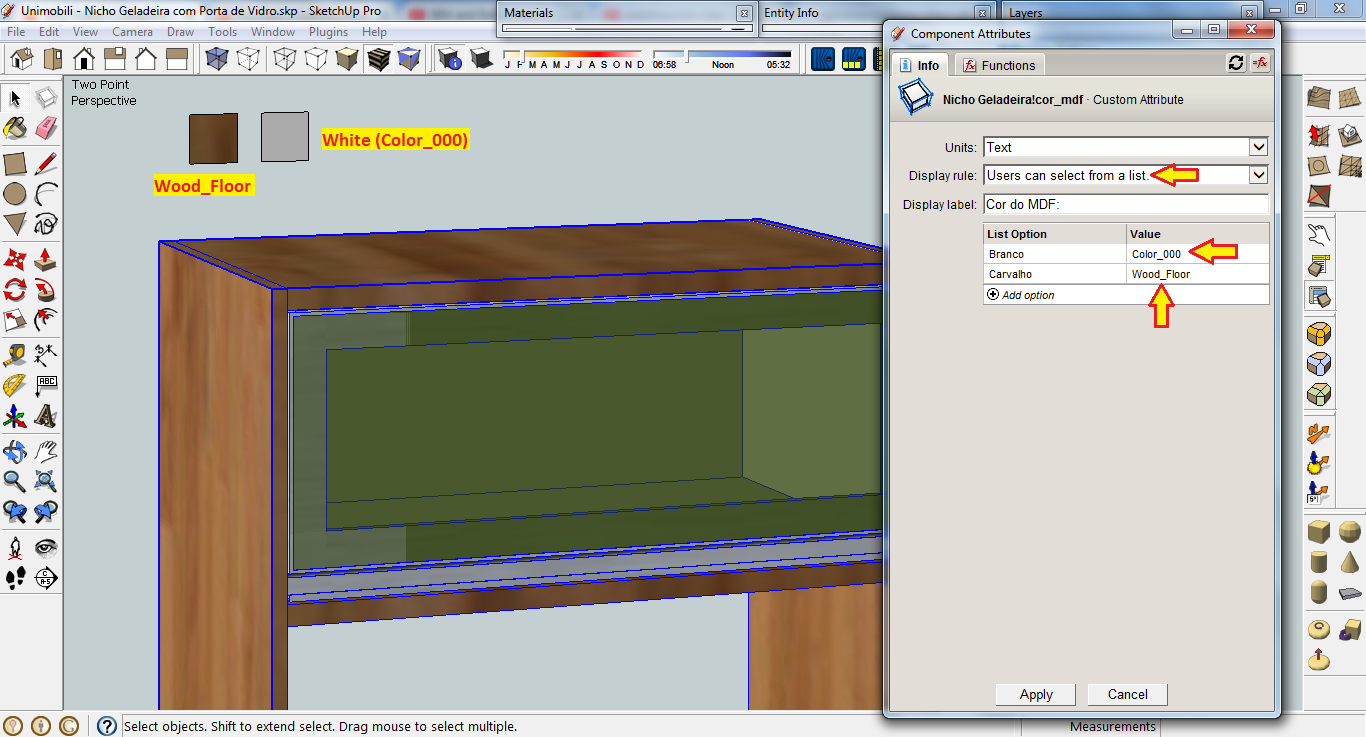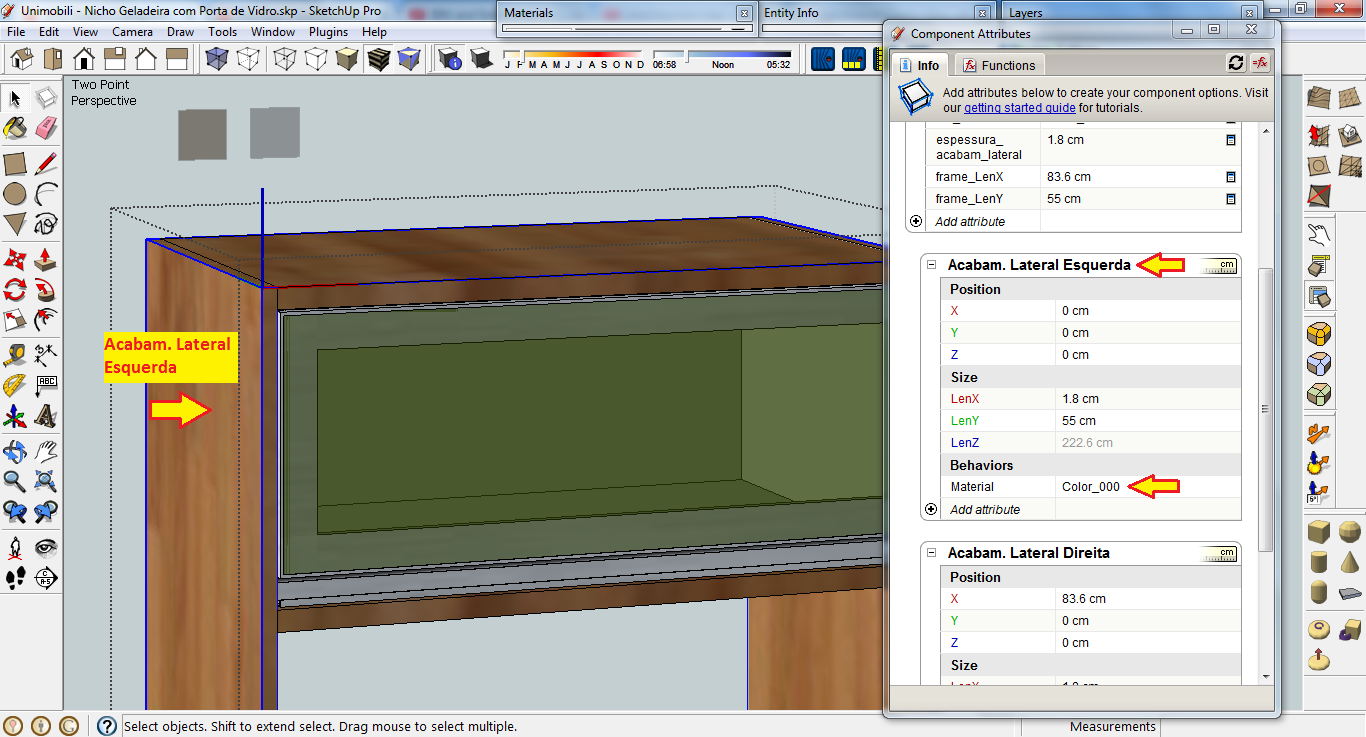Why Doesn't Component's Material Change?
-
@rich o brien said:
To see what's applied/available you need to set the Materials library to In Model
To see the materials you have in model, you click on the little house icon on the top left of the materials list.
The list will then be called "In Model", not "Wood" nor "Minecraft".
If you don't do what TIG suggests (swatches hidden inside the DC) you will not be able to use that DC in models that don't have those materials.
-
the material "Wood_Floor" is available in Model. so, it was supposed to work.
-
You have not demonstrated that 'Wood_Floor' is available in the model.
Your screen-shots show it in a collection named 'Wood', that is external to the model.
If you click the 'house' icon to show what's in the model is it also there ?As has previously been explained a DC which doesn't have embedded swatches of materials is doomed to fail, because one day the named material will not be found...
-
If you click on a material from the libraries it becomes available in model but not applied to any face.
You should have tiny faces hidden inside your component, each face with a material variation you need on the Dynamic Component, in order to transport the material with the component to wherever it goes.
-
please, take a look at the attached picture and tell me what is missing.

-
material behavoir setting.

-
You tantalizingly never show us everything we need to make a defintive comment...
However, try this...
Open your Material Browser and set 'Wood_Floor' as the current material.
Paint it onto something manually.
Now open the Ruby Console and paste these lines + enter...p Sketchup.active_model.materials.current.display_name p Sketchup.active_model.materials.current.nameIt will show the Material's display_name and its name - note that these don't always match, depending on how the material is created / imported...
e.g.
"Wood Floor"
"[Wood Floor]"Since the DC code needs the Material's name, then it fails if the material has been added to the model because the actual name is different from what is displayed - the surrounding [...] shows that.
Importing it whilst it's within the DC may well use another naming convention that will work... try it... -
@TIG, is this your defintive comment? because it didn't work anyway. I opened Ruby Console, run both lines of code that you suggested and noticed that the white color name for both display and current's name are the same: Color_000. exactly the same name I used in the material behavior setting. it didn't change the color to white, which, according to you, it should work. the same happened to the Wood Floor material, which display and current's name are saved as Wood Floor and [Wood Floor], respectively.
-
You misconstrue what I said.
This IS my definitive comment !I simply want you to set 'Wood_Floor' as the current [applied] material in the model and then get its 'display_name' and 'name' - which could be different...
You then confirm that they are indeed different...But somehow deny this is true ??
But it is !Also I did not ask you to do anything with any other material, and I did not suggest that somehow my code snippets would change anything in the model - they were just there to report the facts !
Do you not see my simple point ?
Even if 'Wood_Floor' is in use in the model, then its 'displayed name' and its actual 'data-base name' might vary, so then your DC code could fail because it can't find the material 'by name' as it's not what shows in the Materials Browser dialog...
BUT, if you were to include the required material applied onto a swatch hidden within your DC, then you have a much better chance that it will be recognized by name and therefore used without an error...
-
Hey Kid. Do both these things:
- Don't make Tig loose his coolness, we need him to keep cool as ever
 .
. - Do the following, step by step:
- Edit the component you are making;
- Draw a rectangle for each material you will need that component to have;
- Paint each rectangle with the corresponding material;
- Go to Material browser and hit the little house icon;
- Above the list, to the right there's a blue and white arrow icon pointing right which read details when you hover over it. Click it and choose List View;
- This list now shows the names of the materials you used in model;
- It might also list a lot of materials you are not using but clicked on so they got into the model;
- Go to the details arrow again and choose the purge option;
- The material names you can use in the DC component are somewhere within the resulting list.
- Never erase the squares you drew initially;
- If you need to hide them from view, then shrink them as small as you wish, and hide them inside the model. (you can really hide the objects too by selecting them all, right clicking on one of them and use the hide command.)
- These little squares are the swatches Tig told you about.
- Don't make Tig loose his coolness, we need him to keep cool as ever
-
@TIG, I did not misconstrue what you said. if I made you to understand so, l apologize.
I have another DC which has basically the same structure (with mother component and subcomponents) and it is working pretty fine. I can change its material thru the dropdown list that I put available on the component options screen. and I didn't need to do all those changes to make it work.about the white color, what I wanted to say is that it is saved in the system as Color_000, both display and current name. I set the material behavior to the same Color_000, which was supposed to change the component color to white but it didn't happen, unsuccessfully. on the other hand, when I use the bucket tool to paint the component (not the faces), it works.
-
@JQL, all of those steps were already taken by me. if you take a look at the attached pictures, you'll be able to see those "little squares", that you mentioned, placed right above the cabinet. I believe that I'm dealing with one more of many bugs found in SketchUp.
I don't know what really is doing him lose his "coolness" but this chat has more to do with an air conditioner machine
 .
. -
A material has to have been used in the model, simply making it current is not enough.
Perhaps this is the Color_000 issue ?
http://sketchucation.com/forums/viewtopic.php?f=180%26amp;t=33847As has been spelled out several times, adding small painted faces within some part of the DC is the sure way of having these available to use in the DC, however there is this potential difference between the material .name and its .display_name
The enclosing [...] etc show this.
Try using those for the material name, rather than the display name.
The code snippet I gave allows you to get any material's dual names.
I understand that the [...] indicate the material was at some time loaded into a model and not created from scratch.
It has been like that since v6.0Class: Sketchup::Material
The Sketchup::Material class represents a Sketchup::Texture or Sketchup::Color that can be applied to Sketchup::Drawingelements.
SketchUp Ruby API Documentation (ruby.sketchup.com)
Since you are shipping the materials you can choose the re-name them using the >=v8.0 method:
material.name="some_name"A quick way to do this could be this snippet...
Sketchup.active_model.materials.each{|mat| p n=mat.name; p d=mat.display_name; mat.name=d; p mat.name }
This processes all of the materials currently used in the model and sets the mat's name to the display_name - thereby sidestepping any difference between the two...
It prints each material's name, display_name and final name - this safety-net is in case the new name is already taken by another material, in which case it'll get a numerical suffix added...This has been cover ages ago by thomthom, here... some of his points have already been added to the API notes...
http://www.thomthom.net/thoughts/2012/03/the-secrets-of-sketchups-materials/
Advertisement








